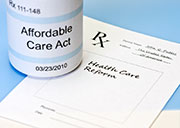- Stigma, Shame Hit Many Gay Men Affected by Mpox Outbreak
- Calories, Not Meal Timing, Key to Weight Loss: Study
- Dietary Changes May Beat Meds in Treating IBS
- Screen Pregnant Women for Syphilis, Ob-Gyn Group Advises
- Even With Weight Gain, Quitting Smoking in Pregnancy Still Best for Health
- A-Fib Is Strong Precursor to Heart Failure
- One Neurological Factor Keeps Black, Hispanic Patients From Alzheimer’s Clinical Trials
- Managing Blood Sugar After Stroke Could Be Key to Outcomes
- Dozens of COVID Virus Mutations Arose in Man With Longest Known Case
- Blood Test Might Someday Diagnose Early MS
More Americans Getting Needed Health Care, Survey Shows


Although problems persist, more Americans had significantly less trouble getting and paying for needed medical care in 2014, as the health insurance expansions of the Affordable Care Act kicked in, a new survey suggests.
The number of working-age adults who said they didn’t get the care they needed because of the cost dropped to 66 million in 2014 from 80 million in 2012 — the first decline since 2003, according to The Commonwealth Fund’s latest Biennial Health Insurance Survey.
At the same time, fewer adults — 64 million in 2014 versus 75 million in 2012 — reported medical bill problems, and that’s the first decrease since 2005.
“This new report provides evidence that the Affordable Care Act’s new subsidized options for people who lack insurance from employers are helping to reverse national trends in health care coverage and affordability,” Commonwealth Fund President Dr. David Blumenthal said in a news conference with reporters Wednesday afternoon.
Uninsured rates tumbled to their lowest levels in more than a decade, the survey found. A total of 29 million working-age adults (16 percent of the population) were uninsured in 2014, down from 37 million (20 percent of the population) in 2010.
It is “the first statistically significant decline measured by the survey since it began in 2001,” noted Sara Collins, vice president for health care coverage and access at The Commonwealth Fund, which publishes the nation’s longest-running nonfederal survey of health insurance coverage.
The Affordable Care Act, or “Obamacare,” broadened access to health coverage through Medicaid and private health insurance subsidies. Just 26 states and the District of Columbia expanded Medicaid in 2014, after the U.S. Supreme Court allowed states to opt out of that requirement.
Beginning in September 2010, the health reform law made it possible for young adults under the age of 26 to remain on their parents’ health insurance plans.
The survey shows young adults realized the greatest gains in coverage of any age group. Among 19- to 34-year-olds, 19 percent were uninsured in 2014, down from 27 percent in 2010.
Low-income adults also saw vast improvements in their insurance status. Among adults with incomes below 200 percent of the federal poverty level , or $47,100 for a family of four, the percentage remaining uninsured fell to 24 percent in 2014 from 36 percent in 2010.
Under the Affordable Care Act, individuals and families with incomes up to 400 percent of the federal poverty level, or $94,200 for a family of four, may qualify for subsidies to defray the cost of health insurance coverage purchased through the law’s federal and state exchanges. Those with incomes up to 250 percent of poverty, or $58,875 for a four-person family, may be eligible for reduced cost sharing.
However, the survey found that uninsured Americans, including low-income people in states that did not expand Medicaid, are still having problems paying medical bills. Fifty-seven percent who were uninsured during the year skipped needed care because of the cost, and 51 percent reported medical bill problems.
“The Affordable Care Act was all about creating access to the health care system for more consumers, and it’s done that,” said Katie Vahle, co-founder of CoPatient, a Boston-based company that reviews and negotiates medical bills. But the coverage expansion “doesn’t eliminate medical debt.”
Her company advocates for people who find themselves struggling with medical expenses, often because they selected “bronze” level coverage that pays for only 60 percent of their health care costs, or they inadvertently used health care providers who were not part of their health plan network.
Dr. Stephanie Woolhandler, a public health professor at the City University of New York at Hunter College and an advocate of a “single-payer” health system, said the law improves access to care for many low-income Americans but doesn’t solve America’s health care crisis.
About one in six working-age adults still lack health insurance, Woolhandler pointed out. “As a physician, I find that unacceptable,” she said.
What’s more, prior reports from The Commonwealth Fund suggest that many low- and moderate-income people in private health plans, including employer-sponsored coverage, are avoiding or delaying care due to rising deductibles and co-payments.
Collins predicted that declines in the nation’s uninsured will likely continue as more people gain coverage through the health insurance exchanges and Medicaid. But she acknowledged that the recent growth in cost-sharing “could be a countervailing factor,” reversing the decline in people’s ability to get health care and pay their medical bills.
Another looming threat is the upcoming Supreme Court case challenging whether the federal government can legally subsidize coverage in the 34 states that chose not to run their own health insurance exchanges.
A court ruling in favor of the plaintiffs “will have a major effect on many aspects of the law in states that do not have state-established exchanges,” Blumenthal said. If that were the case, the number of Americans who can get and afford health insurance would be expected “to revert to the kinds of numbers that were observed before the Affordable Care Act went into effect,” he said.
The 2014 survey, conducted between July and December, is based on telephone interviews with 4,200 adults, aged 19 to 64.
More information
Visit healthcare.gov for more on the Affordable Care Act.
Source: HealthDay
Copyright © 2024 HealthDay. All rights reserved.










